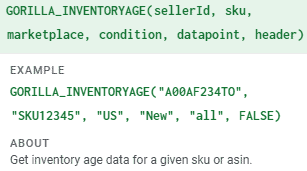The Inventory Age report will be discontinued in 2022.
Use the new INVENTORY HEALTH function.
The Inventory Age report will be discontinued in 2022 and is being replaced by the new Manage Inventory Health report. The Manage Inventory Health report is the former Inventory Age report but now combines the best of the Inventory Age, Inventory Health, and Excess Inventory report metrics across sales, shipment statuses, estimated fees, storage volume and type, and aged and excess inventory. To learn more, go to Manage Inventory Health overview. You’ll still be able to access and download the Inventory Health report through 2021.
Sample Usage
🚨 Use ranges (e.g.A2:A1000) in your formula wherever possible for quicker results and to prevent Google from blocking your account for 24 hrs due to overloading their resources.
=GORILLA_INVENTORYAGE("TOY STORE", A1:A100)
=GORILLA_INVENTORYAGE("TOY STORE", A1:A100, “US”, “NEW”, ,TRUE)
=GORILLA_INVENTORYAGE("TOY STORE", A1:A100, , , “inv-age-91-to-180-days”)
Syntax Description

Description:
Get inventory age data for a given sku or asin.
Syntax:
GORILLA_INVENTORYAGE(sellerID, sku, [marketplace], [condition], [datapoint], [header])
sellerId – REQUIRED
Seller account or Nickname to work with.
sku – REQUIRED
SKU or ASIN to filter the results. Can be a range of values like A1:A100 where A1 to A100 consists of values like SKU111, SKU222, SKU333 or ASIN123… If point is also specified, only single value or a column of skus can be provided.
marketplace – OPTIONAL
Marketplace filter. Use All for all marketplaces and Default for the seller default. Other valid values are country codes US, IT, etc. or Amazon Marketplace ID like ATVPDKIKX0DER.
condition – OPTIONAL
Return only data for specific product condition. Default is empty value for any condition type. Other Valid values are: ‘New’, ‘Used’.
datapoint – OPTIONAL
Return data for specific data point. Default is empty value which will load the data for all the following data points.
- inv-age-0-to-90-days
- inv-age-91-to-180-days
- inv-age-181-to-270-days
- inv-age-271-to-365-days
- inv-age-365-plus-days
- qty-to-be-charged-ltsf-6-mo
- projected-ltsf-6-mo
- qty-to-be-charged-ltsf-12-mo
- your-price
- sales-price
header – OPTIONAL
Show column header when data point is not specified, TRUE to show header, FALSE (default) to not show it.
Examples:
🚨 Use ranges (e.g.A2:A1000) in your formula wherever possible for quicker results and to prevent Google from blocking your account for 24 hrs due to overloading their resources.
=GORILLA_INVENTORYAGE("TOY STORE", A1:A100)
The most basic table format where the SKUs or ASINs are listed from A1 to A100.
It will list all the “datapoints” in the previous section above, without a header.
=GORILLA_INVENTORYAGE("TOY STORE", A1:A100, “US”, “NEW”, ,TRUE)
Returns a table of results. All datapoints will be listed for SKUs listed in A1:A100 , for the US market, in new condition. The TRUE condition will display a table header.
=GORILLA_INVENTORYAGE("TOY STORE", A1:A100, , , “inv-age-91-to-180-days”)
Bulk returns a list of results for SKUs listed in A1:A100 showing how many units of each sku is aged inv-age-91-to-180-days.